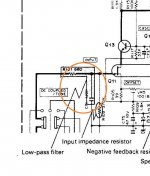Predicting exactly what conditions will trigger a parasitic oscillation are a bit like predicting the weather; possible in principle, but not always in practice due to chaotic behaviour. Try simple waveforms first, at various levels. You already know the volume control setting which makes the problem appear - that may suggest that the parasitic is in the next stage after that (and affected by impedance), but it could be somewhere else.
Three thoughts in no particular order:
1/ It uses an STK output chip. Prime suspect number #1
2/ Speaker relays can do odd things as current through the contacts rises (signal dependent).
3/ Scope it under the conditions you hear the noise. You should be able to winkle enough info from the scope display to get a hint of what is going on. Use DC coupling for the scope.
1/ It uses an STK output chip. Prime suspect number #1
2/ Speaker relays can do odd things as current through the contacts rises (signal dependent).
3/ Scope it under the conditions you hear the noise. You should be able to winkle enough info from the scope display to get a hint of what is going on. Use DC coupling for the scope.
I would work with various sine tones to determine if the problem appears on a certain position of volume pot, at a certain voltage of the input signal or at a certain output power.
I got it!.... The low pass filter at the input of the power amp made of 680 ohm series, 120 pF ceramic parallel elements. Corner frequency: 1.95 MHz (WTF?).
Not only the frequency is stupid, but the ceramic cap was in a suspect condition.
(its case was cracked, I guess it worked as a ceramic resonator circuit at some frequencies)
Replaced it with a 1 kOhm - 330 pF styrene cap combo, et voilá, problem solved.
Clean as a bat's whistle....
Big thanks for all of your help guys....
Not only the frequency is stupid, but the ceramic cap was in a suspect condition.
(its case was cracked, I guess it worked as a ceramic resonator circuit at some frequencies)
Replaced it with a 1 kOhm - 330 pF styrene cap combo, et voilá, problem solved.
Clean as a bat's whistle....

Big thanks for all of your help guys....
Attachments
Last edited:
What? Believe one of your senses? Go wash your mouth out! 😀Well done
A visual inspection is often just as important as getting the test gear out.
What? Believe one of your senses? Go wash your mouth out! 😀
He -he .... If we would believe in our senses just a bit more, there would be not this many crappy pieces of audio gear around.
Personally I trust my hearing much more, than any technical mumbo - jumbo fed to us from those who "know better" based on science, authotity and measurements.
If we believed our senses a bit less we might get less audio mumbo-jumbo fed to us from true believers who 'know better' based on anecdote, fashion and sighted 'listening tests'.
So then..: Buy your stuff based on "expert's" opinions, well established technical brochures containing the truth -and only the truth- , and data sheets, distrusting your senses? Hmm... well ,do so, but I will stay with the old primitive method 😱
Believe your senses, after all they have helped us all to stay alive, so far. But also keep in mind that senses may be elusive. Our impressions will also depend on our mood, tiredness, time of the day, as well as of mental overwhelming or the one coming from other senses in a given moment.
If we believed our senses a bit less we might get less audio mumbo-jumbo fed to us from true believers who 'know better' based on anecdote, fashion and sighted 'listening tests'.
I think these two posts neatly sum up the split. Some with training and degrees are blinded by them to anything that contradicts what they have been taught. Some who simply listen are blind to tests and measurements. Fortunately some can cope with both.So then..: Buy your stuff based on "expert's" opinions, well established technical brochures containing the truth -and only the truth- , and data sheets, distrusting your senses? Hmm... well ,do so, but I will stay with the old primitive method 😱
I got it!.... The low pass filter at the input of the power amp made of 680 ohm series, 120 pF ceramic parallel elements. Corner frequency: 1.95 MHz (WTF?).
Not only the frequency is stupid, but the ceramic cap was in a suspect condition.
Replaced it with a 1 kOhm - 330 pF styrene cap combo, et voilá, problem solved.
Clean as a bat's whistle....
Hi Dragonweed
I'm sorry to spoil the party, but your calculation is wrong.
The impedance driving the the original 120pF capacitor is, 680 Ohms more the output impedance of the volume pot, that in the worst scenario (middle point) can be 25.000 Ohms, (25K) for a 100K pot.
Cheers 😉
Last edited:
- Status
- Not open for further replies.
- Home
- Amplifiers
- Solid State
- Really weird problem with volume control

